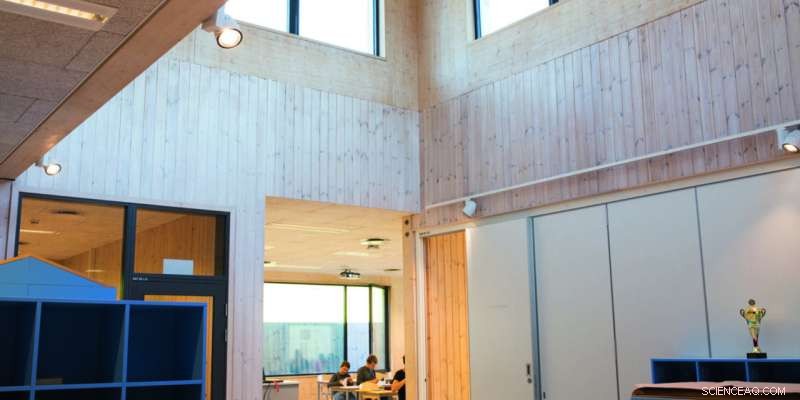Hvordan påvirker lys børn i skolen?

Forskere har samlet vores nuværende viden om, hvordan lys påvirker skoleelever. Deres resultater kan resultere i mere læring og mindre forstyrrelse. Billedet viser 7. klasses elever, der hygger sig på Ulsmåg skole i Bergen. Kredit:Arkitekter:Ola Roald Arkitektur. Foto:Eva Rosa Hollup
Vidste du, at lys er en faktor, der påvirker både læring og den psykologiske udvikling hos skolebørn? Den rigtige slags lys kan øge præstationerne i læsning, skrivning og matematik og undertrykke rastløshed og aggression.
Vi har nu omfattende videnskabelige beviser for, hvilke effekter lys har på mennesker. For eksempel er lys direkte forbundet med vores døgnrytme.
Denne rytme tilpasser vores kroppe til en 24-timers cyklus af lys og mørke. Lys regulerer sådanne ting som vores søvnmønster, kropstemperatur og niveauer af stresshormoner Dagslyset er med andre ord afgørende for at sikre, at vores døgnrytme fungerer, som den skal.
SINTEF har for nylig afsluttet et projekt, der skal samle alle eksisterende forskningsresultater på dette område. Resultatet er et sæt helt nye retningslinjer for, hvordan belysning i skolebygninger skal udformes.
"Da lys påvirker elever i forskellige områder, er det vigtigt at forske mere i, præcis hvordan lys kan bruges i norske skoler," siger SINTEF-forsker Claudia Moscoso. "Velbelyste læringsrum kan understøtte uddannelse og fremme god fysisk og psykisk udvikling blandt skoleelever," siger hun.
Lysforhold er meget vigtige for børn i skolen, som bruger meget af deres tid indendørs. Det påvirker deres årvågenhed, kognitive færdigheder og niveauer af stresshormonet kortisol. Desuden er forholdene i Skandinavien sådan, at deres eksponering for blåt lys om morgenen reduceres i de lange vintermåneder. Dette lys er afgørende for at aktivere vores biologiske ure.
Store vinduer fører til bedre eksamensresultater
For eksempel fandt en britisk undersøgelse udført i 2015 (HEAD-projektet), som indsamlede data fra 3.766 skolebørn i Storbritannien, at veldesignede grundskoler tjente til at øge elevernes akademiske præstationer i læsning, skrivning og matematik. Et fund af særlig interesse var, at 16 procent af variationen i læringsudvikling over en etårig periode kunne forklares med den fysiske udformning af klasseværelset.
Disse resultater viste tydeligt, at lys var den faktor, der havde den største effekt (21 procent), mens luftkvalitet (16 procent) og temperatur (12 procent) også havde stor indflydelse. Disse tre faktorer var således ansvarlige for næsten halvdelen af effekten på læringsudvikling.
En anden videnskabelig undersøgelse viste, at klasseværelser med store vinduer var forbundet med mellem 15 og 23 procent af forbedringen i elevernes eksamensresultater. It also showed that adequate and stable daylight conditions throughout the year boosted academic skills by between 20 and 26 percent, compared with classrooms with low levels of daylight.
Does adequate lighting promote less absenteeism?
A third study found that classrooms with adequate access to daylight and sunlight were associated with less pupil absenteeism and improved academic skills. On the other hand, classrooms with inadequate lighting design can restrict pupils' ability to learn. This is because low levels of lighting can impact on a child's visual system and thus restrict access to visual information and suppress learning ability.
In fact, the difference between classrooms with windows (providing adequate daylight conditions) and those without has been found to influence cortisol levels in children, which in turn are associated with pupils' psychological health and levels of concentration in the classroom. Another major research project , which used data taken from 2,837 schoolchildren aged from eight to 12, found that pupils working in classrooms with large windows exhibited better academic skills compared with those in classrooms with less window area.
In the case of artificial light, research studies have found that variable levels of lighting (i.e. Illumination that varies both in strength and color temperature) serve to boost academic skills in reading speed and comprehension. For example, skills in reading aloud were increased for 38 percent of pupils working under variable lighting conditions, compared with only 18 percent for those under normal white light.
It has also been found that blue-enriched white light reduces restlessness and aggressive behavior among schoolchildren compared with standard white light.

The entrance area of Fagereng school in Tromsø photographed in daylight during the summer (left) and under artificial lighting in winter (right). Architects:Fråne Hederus Malmström arkitekter and Arkitektlaget. Credit:HMXW arkitekter and Solvår Wågø/SINTEF
Many variables
Even though minimum lighting requirements have been stipulated for Norwegian schools, these do not in fact guarantee adequate lighting quality in any given school space. For example, the requirements linked to daylight, such as daylight factor (DF), describe an average value for overcast weather.
"If a classroom only succeeds in achieving the minimum requirement of 2 percent DF as set out in the Norwegian statutory building regulations (TEK17), or the Lyskultur recommendation of 5 percent DF, the same classroom may still encounter issues with glare or overheating under clear skies," explains Moscoso.
Moreover, the requirements for artificial light offer inadequate information about the color temperature of the light source. In fact, research has shown that the color temperature of a light source impacts on both the behavior and psychological and mental states of pupils.
So, in order to carry out a comprehensive assessment of lighting conditions in schools, we have to analyze other parameters. For example, classrooms should be monitored to identify issues linked to glare. We should be noting the colors of surfaces and assessing whether the pupils' visual environment is good enough to provide them with mental and visual "relief."
Linked to architecture
Classrooms and group rooms are among the most important learning spaces in any school.
"This makes it very important to evaluate the floor plans and physical design of such spaces," explains Moscoso. "For example, we must look at daylight openings (windows and skylights, if any) and their design, the types of glass, installation angles, as well as the accessibility of sun-screening or daylighting systems," she says.
The aim of daylighting systems is to make better use of daylight, for example by allowing it to penetrate deeper into a space, or by distributing the light more evenly. Even if these factors have already been considered during the design phase, it is also common to retrofit them in existing buildings.
"It's also beneficial to focus on the arrangement of furniture in a space, the color and reflectivity of surfaces, and the location of whiteboards and suchlike. This can provide us with important input during our analyses of light distribution, contrasts and factors that can cause glare," says Moscoso.
Improving light conditions
The researchers have now attempted to identify a suitable method that incorporates the most important factors that should be assessed in the search for a well-lit classroom. Their literature review offers an evaluation of the most important aspects of lighting in school spaces and the methods that can be used to record light conditions in our schools.
"This information can be used in the future either to evaluate and improve existing light conditions in schools, or serve as a set of recommendations during the planning of new schools designed to support learning and well-being," says Moscoso. + Udforsk yderligere
Smart lighting system based on quantum dots more accurately reproduces daylight
 Varme artikler
Varme artikler
-
 Hvad er en bedre isolator: papir, glas, plastik eller styrofoam?Et materiales varmeledningsevne bestemmer, hvor god en isolator det er. Den officielle definition af termisk ledningsevne er mængden af varme, der overføres gennem en enhedstykkelse i en retning,
Hvad er en bedre isolator: papir, glas, plastik eller styrofoam?Et materiales varmeledningsevne bestemmer, hvor god en isolator det er. Den officielle definition af termisk ledningsevne er mængden af varme, der overføres gennem en enhedstykkelse i en retning, -
 Hvem køber vinen? Forskning afslører, hvordan forbrugerne træffer valg for grupperKredit:CC0 Public Domain Når man får til opgave at træffe valg for en stor gruppe, som at vælge vin til bordet, uafhængige mennesker træffer typisk valg, der i højere grad afspejler deres egne præ
Hvem køber vinen? Forskning afslører, hvordan forbrugerne træffer valg for grupperKredit:CC0 Public Domain Når man får til opgave at træffe valg for en stor gruppe, som at vælge vin til bordet, uafhængige mennesker træffer typisk valg, der i højere grad afspejler deres egne præ -
 Gå ikke i panik:Erfaringer fra Hawaii falsk alarmKredit:CC0 Public Domain Da Hawaii-øernes beboere modtog en falsk alarm-sms, der sagde Ballistisk missiltrussel på vej til Hawaii. Søg øjeblikkeligt ly. Dette er ikke en øvelse, i januar 2018, res
Gå ikke i panik:Erfaringer fra Hawaii falsk alarmKredit:CC0 Public Domain Da Hawaii-øernes beboere modtog en falsk alarm-sms, der sagde Ballistisk missiltrussel på vej til Hawaii. Søg øjeblikkeligt ly. Dette er ikke en øvelse, i januar 2018, res -
 Ostefremstilling i Nepal truet, medmindre pastoristiske traditioner genoplivesEn hyrdegruppe flytter deres lejr og dyr mellem græsgange i Upper Langtang Valley. Kredit:Austin Lord Nepals Langtang-dal er kendt for mange ting, fra dets bemærkelsesværdige Himalaya-landskaber,
Ostefremstilling i Nepal truet, medmindre pastoristiske traditioner genoplivesEn hyrdegruppe flytter deres lejr og dyr mellem græsgange i Upper Langtang Valley. Kredit:Austin Lord Nepals Langtang-dal er kendt for mange ting, fra dets bemærkelsesværdige Himalaya-landskaber,
- Finder fusionerende galakser
- Husholdnings aerosoler frigiver nu flere skadelige smogkemikalier end alle britiske køretøjer
- Forskere skaber den første 2D-elektride
- Carbon nanorørfibre skaber overlegne forbindelser til hjernen
- 1N4007 Diode Specs
- National undersøgelse viser, at rekreation mellem hav og kyst er en stor forretning


